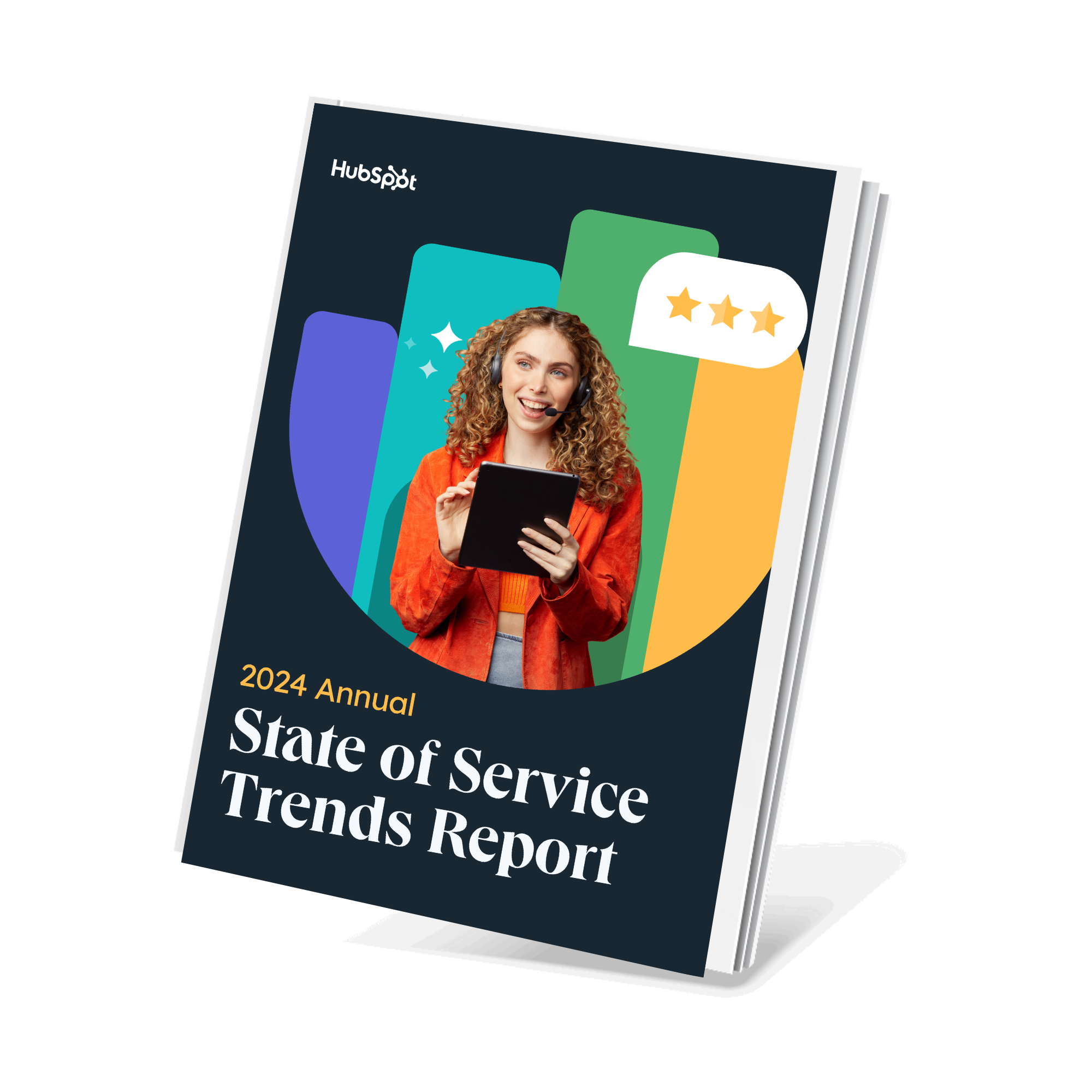Have you noticed lately that you’re surrounded by examples of AI in customer service? Whether it’s a chatbot that’s processing a clothing refund for you, an AI rep booking a flight for you, or an app that’s creating a personalized experience for you – companies of all backgrounds are experimenting with ways to deliver better customer service through AI.

As a savvy shopper, I highly welcome this trend. Companies that are using these technologies are often quicker to respond to my needs and focused on delivering a helpful outcome. As someone who loathes spending hours on the phone just to reach a customer service rep that can fix my issue, I can see a ton of value in implementing more AI solutions.
And most service leaders today agree. According to HubSpot’s annual State of Service report, 86% of leaders say that AI will completely transform the experience that customers get with their company.
Are you wondering how best to incorporate AI into your customer service offerings and what you can learn from successful companies? I’m here to help! I’ve gathered some of the top highlights from the State of Service report to show you what the latest data reveals. I’ll also walk you through different ways you can use AI in your CS strategy, along with a few of my favorite examples.
Table of Contents
- AI in Customer Service
- Benefits of AI in Customer Service
- Top Ways Customer Service Teams Use AI [New Data]
- How to Use AI in Customer Service
-
Factors to Consider Before Implementing AI for Customer Service
- Examples of AI in Customer Service
- The Future of AI in Customer Service

The State of Customer Service Report
Unlock essential strategies for exceeding customer expectations and driving business growth in a competitive market.
- Exclusive insights from worldwide CRM leaders
- Analysis of modern customer behaviors
- Closer look at the AI opportunity in CRM
- Strategies for staying agile in 2024 and beyond
Download Free
All fields are required.

AI in Customer Service
In customer service, AI is used to improve the customer experience and create more delightful interactions with consumers. Technologies like chatbots and sentiment analysis can help your support team streamline their workflow, address customer requests more quickly, and proactively anticipate customer needs.
When implemented properly, using AI in customer service can dramatically influence how your team connects with and serves your customers.
This video outlines a few of the ways that AI is changing the way we think about customer service.
Let's take a look at some of the benefits.
Benefits of AI in Customer Service
- Improved Customer Support Workflows
- Reduced Response and Handle Times
- Better Predictions of Customer Behavior
- Consistency in Responses
- Data Insights fro Real-time Data
- Personalized Service Interactions
- Employee Burnout Reduction
- 24/7 Availability

Improved Customer Support Workflows
AI technology can be used to reduce friction at nearly any point in the customer journey.
Chatbots allow you to quickly answer routine questions from new customers.
AI helps you streamline your internal workflows and, in return, maximize your customer service interactions. The example below shows how you can automate a large portion of your incoming tasks and then intelligently hand them over to the support rep once needed.
Reduced Response and Handle Times
With improved workflows, AI can give you better customer response metrics. According to our research, 64% of service leaders say that AI helps reduce the amount of time customer service reps spend resolving tickets/issues.
Using chatbots as an example, you can automatically respond to a customer‘s live chat message within seconds. This will decrease your support team’s first response time significantly.
The result? Your average handle time will go down because you're taking less time to resolve incoming requests.
Better Predictions of Customer Behavior
Understanding demanding customer expectations and predicting/addressing customer issues before they occur is one of the top challenges service leaders face today. AI can help you make predictions using real-time data.
That means you can use AI to determine how your customers are likely to behave based on their purchase history, buying habits, and personal preferences.
Predictive AI can help you identify patterns and proactively make improvements to the customer experience.
Consistency in Responses
It's vital to provide a clean and consistent customer experience no matter when the customer is on their journey. AI can provide uniform and standardized responses to customer inquiries, ensuring consistency and accuracy.
Data Insights from Real-Time Data
AI tools can analyze customer service interactions to identify trends, common issues, and areas for improvement. These insights help companies enhance their products, services, and customer support strategies based on real-time data.
For example, HubSpot offers Breeze Intelligence to enrich your Smart CRM. Enhanced with advanced LLMs and AI data sourcing, it consists of over 200 million buyer and company profiles. This technology can improve form conversion rates, identify buyer intent from companies visiting your website, and keep your database fresh with regular updates.
Personalized Service Interactions
Another feature of Breeze Intelligence is data enrichment, which makes it easy to add more information to your records, and personalize service interactions.
Breeze Intelligence data enrichment services include company details and recent news that your marketing, operations, and sales team can use to make their email content more personal and relevant to prospects, improving response rates.
Your team can better personalize interactions both before and after purchase to make sure your customers are getting the attention and service they need and deserve.
Employee Burnout Reduction
Many tend to forget that AI is a tool that's supposed to make your work smarter — not harder.
With the time saved from manual information gathering, manually reaching each and every request, or trying to brainstorm your everchanging support strategy, using AI can relieve many of those pains and give your team more peace of mind — without foregoing quality and efficiency.
24/7 Availability
Another perk of using AI is that it can work beyond your company's time zone.
Customers won't need to unnecessarily wait for a human employee to respond to their inquiry when a chatbot can gather all the basic information needed to address their problem before they even get connected to a rep.
Now, let's review how to put some of these benefits into practice.
Top Ways Customer Service Teams Use AI [New Data]
It’s probably no surprise that AI is one of the leading priorities among CS leaders. But our State of Service data sheds new light on how AI is reshaping CS teams.
Here are some of the highlights to know:
- 77% of customer experience teams already use AI with great results – including improved customer service response time, improved CSAT, and lower spend on customer service.
- AI chatbots are the most effective CS channel and will see the most investment in 2024
- Leaders see the future of customer service being driven by AI-power reps.
- 72% of CS leaders say AI can provide better customer service than a human can.
- 86% of leaders using AI say it improved their ability to scale customer service operations as their company grows.
It’s clear to see the value that AI can bring to your customer service operations. Whether you’re looking to scale through AI-powered reps, offer omnichannel support, or increase the personalization of your CS strategy, there are many ways you can incorporate it.
Looking for inspiration? Here are some of the highest ROI strategies for CS teams using AI:
- Using AI chatbots.
- Offering omnichannel customer support.
- Leveraging AI/automation throughout the customer experience.
- Collecting and analyzing customer feedback.
- Using generative AI for crafting communications with customers.
This is just a glimpse. Keep reading to learn practical tips for how you can add AI in your customer experience strategy – and learn from a few top companies’ use cases.

The State of Customer Service Report
Unlock essential strategies for exceeding customer expectations and driving business growth in a competitive market.
- Exclusive insights from worldwide CRM leaders
- Analysis of modern customer behaviors
- Closer look at the AI opportunity in CRM
- Strategies for staying agile in 2024 and beyond
Download Free
All fields are required.

How to Use AI in Customer Service
Here are ten ways I recommend using AI for customer service based on our State of Service data. We'll review each in more detail below.

1. Chatbots
We‘ve mentioned chatbots a lot throughout this article because they’re usually what comes to mind first when we think of AI and customer service.
Chatbots are programmed to interpret a customer’s problem and then provide troubleshooting steps to resolve the issue. This saves time for your reps and your customers because responses are instant, automatic, and available 24/7.
According to our research, chatbots are also the most effective channel for CS teams. Leaders predict that by 2025, AI will be able to resolve a majority of tickets without involving a customer service rep.
Pro tip: HubSpot's ChatSpot is a conversational CRM bot that service professionals can connect to HubSpot to maximize productivity.
2. Augmented Messaging
While chatbots are great at troubleshooting smaller issues, most aren't ready to tackle complex or sensitive cases.
This is where augmented messaging comes into play. This AI tool identifies opportunities where human agents should step in and help the customer for added personalization.
Here's an example of how this interaction could play out.

Pro tip: While bots are great at saving time for your team and your users, they'll never produce the same customer delight as a human agent. Augmented messaging tools give you the best of both worlds. When I’m dealing with complex problems, I love knowing I’m able to reach a human at the end who can help me.
3. Sentiment Analysis
Today, many bots have sentiment analysis tools, like natural language processing, that help them interpret customer responses.
This tells the bot how to respond when a customer behaves in a certain way, so your bot won‘t escalate the customer’s emotions when it's trying to help them.
Pro tip: Tools like Grammarly's tone detection in the image below can analyze your text and tell you how your message may be perceived by your audience before you hit send. As a writer, I heavily depend on this tool to gut-check how my communications may sound to different audiences.

4. Request Routing and Prioritization
In addition to outgoing messages, you can also use AI to identify keywords and analyze the nature of the request before assigning it to one of your reps.
AI tools allow you to analyze the customer's problem, the perceived urgency, and their associated emotions. You can also program your AI model to tag in the right agent to handle the case.
This is another time-saving process that makes it easier for your support team to troubleshoot and resolve issues.
Pro tip: Reserve your most-experienced agents to handle your complex cases, and allow your newer reps to deal with the simple tickets. Also, consider having reps who are solely dedicated to time sensitive requests.
5. Self-Service Resources
While building out a robust knowledge base or FAQ page can be time consuming, self-service resources are critical when it comes to good CX.
AI can help you synthesize existing information and output copy based on a desired topic. You can then use this copy to create knowledge base articles or generate answers to common questions about your product.
Pro tip: As a content strategist, I love using conversational AI tools like HubSpot's AI content assistant and HubSpot's AI Email Writer to help me create personalized emails and knowledge base articles.
Get access to HubSpot's AI content assistant.
6. Voice Analysis
Behind chatbots and online chats, customers prefer support via phone call, social media, and email.
Voice AI has made it easier to automate call center interactions. These tools can be trained in predictive call routing and interactive voice response to serve as the first line of defense for customer inquiries.
For example, when you call your favorite company and an automated voice leads you through a series of prompts, that's voice AI in action.
Pro tip: Use voice AI technology to resolve routine customer service tasks (like hours of operation requests and account access troubleshooting) so your best agents remain available for more complex issues.
7. Omnichannel Service
AI can support your omnichannel service strategy by helping you direct customers to the right support channels. And according to our State of Service report, omnichannel support is more a necessity for CS teams than a “nice to have.” In fact, 79% of service leaders say customer service needs to be available across every channel customers use.
If all of your chat reps are busy taking cases, the AI can tell the customer that they should use live chat for a quicker response.
Or if a customer is typing a very long question on your email form, it can suggest that they call in for more personalized support.
Here's an example.

Pro tip: When reps are unavailable for callbacks or chat, don‘t give customers the option to select those channels. That way, customers aren’t stuck in a party-of-one conversation wondering why your team hasn't responded.
8. Data Management
Not all AI features are customer-facing. In fact, some of the most useful tools are the ones that are integrated with your internal software.
As an example, AI can be paired with your CRM to recall customer data for your service agents. Your customer success team can use this feature to proactively serve customers based on AI-generated information.
Pro tip: Use AI to track customer engagement data. If a loyal customer hasn't engaged with you in a while, set up systematic AI to proactively flag it and notify your team to reach out.
9. Multilingual Support
Many AI chatbots and conversational tools have the capacity to generate content in different languages. This is especially helpful if your business operates globally.
AI can detect a customer's language and translate the message before it reaches your support team. Or you can use it to automatically trigger a response that matches the language in the original inquiry.
Pro tip: Review your customer profiles or run a survey to gain insight into your customers' preferred languages. Then, incorporate those into your AI strategy.
10. Machine Learning and Predictive Analytics
Machine learning is at the heart of predicting customer behavior through AI.
It's the process of analyzing large quantities of data and pulling out actionable insights that forecast trends, anticipate customer sentiment, and solve future problems.The case from Netflix in the section below is a great example to learn from.
Pro tip: Use predictive analytics to inform your predetermined customer communication responses (e.g., via chatbots or over the phone). Machine learning can help improve the intended output based on FAQs and customer history.
11. Automated Call Transcription
AI call transcriptions are revolutionizing customer service by enhancing call quality assurance through efficient call reviews, aiding in the targeted training of new representatives, and helping identify key service trends and recurrent issues.
These transcriptions offer an objective record for effective dispute resolution and pave the way for personalized customer interactions, ensuring a more tailored and responsive service. By leveraging tools like CallRail's conversation intelligence software, customer service teams can operate with heightened efficiency, ensuring improved customer experiences.

The State of Customer Service Report
Unlock essential strategies for exceeding customer expectations and driving business growth in a competitive market.
- Exclusive insights from worldwide CRM leaders
- Analysis of modern customer behaviors
- Closer look at the AI opportunity in CRM
- Strategies for staying agile in 2024 and beyond
Download Free
All fields are required.

Factors to Consider Before Implementing AI for Customer Service
Before implementing AI, several factors should be considered to ensure a successful integration. Some factors to keep in mind are as follows:
1. Customer Expectations and Needs: Understanding customer expectations and preferences is important. Make sure that the AI solution aligns with what your customers are looking for and enhances their experience rather than complicating it.
2. Quality of Data: AI relies on accurate and relevant data to function effectively. Check that your data is clean, traceable, reliable, and up-to-date to avoid any issues with the AI system's performance.
3. Training and Integration: Proper training and integration of the AI system with your existing customer service processes are vital. Invest time in training your team on how to work with the AI tool and seamlessly integrate it into their workflow.
4. Human Touch: While AI can streamline customer service processes, it's important to maintain a balance with the human touch. Make sure that there are escalation points for more complex issues that require actual support reps or managers to intervene smoothly.
5. Data Security and Privacy: Protecting customer data is important. Ensure that the AI solution complies with your company's data security regulations and follows best practices for data privacy to build trust with your customers.
6. Feedback and Monitoring: Be prepared to continuously monitor and gather feedback on the AI system's performance. Regular analyzation of customer feedback and metrics enable your team to make necessary adjustments and improvements to the AI solution of your choosing.
Examples of AI in Customer Service
- Delta Airlines
- Macy’s
- Netflix's Machine Learning Strategy
Delta Airlines
Delta Airlines uses AI in a variety of ways to make customer interactions with the company “more intuitive, simpler, and less complex for customers.” I use their virtual assistant often to help change flights, monitor flight changes, and process refunds when needed.

Eric Phillips, the chief digital officer, explains how new technologies are creating a better customer experience at the company. It goes far beyond just chatbots. AI is helping the company in all parts of its business, both internally and consumer-facing.
For example, Delta is using AI to parse through vast amounts of data to help with reservation inquiring and pricing. This act alone could help increase the total value of the company by 2%.
The company sets a great example for how the customer service experience and employee experience work together: “It’s not just revenue, and it’s not just efficiency. All those things have to come together. In the end, investing in systems has to make the employee experience better when they’re addressing and interacting with customers. That makes the customer experience better. The revenue play is: ‘I had a good experience, I’m coming back.’”
What you can learn: The goal of Delta’s CX is to communicate to your customers that “we know you, and we value your time.” By applying these same principles and using AI to deliver efficient customer service, you’ll be sure to make a positive impression on your customers.
Macy’s
Macy’s is another company that has found a unique way to incorporate AI into its customer service offerings.
Through cognitive AI technology, Macy’s helps its client navigate its stores and locate associates in a much faster way. This smart-phone-based assistant, “Macy’s on Call,” can offer you personalized answers to your queries. It can help you find certain products or brands in a store and help you find any services or facilities that you’re looking for.

What I like: Personalization is a great approach, considering that personalization is one of the top expectations among consumers 2024, according to our State of Service report.
What you can learn: Use AI to handle the most routine inquiries that you receive so that your human assistants can dedicate more time to solving complex issues.
Netflix's Machine Learning Strategy
Netflix's use of machine learning to curate personalized recommendations for its viewers is pretty well known.

The real value that AI plays here is being able to analyze mass sums of data and use that information to curate a unique customer experience. Netflix’s AI tracks viewing habits, ratings, searches, and time spent on the platform to serve you content that you’re most likely to enjoy.
The streaming giant is also using AI in a variety of ways to enhance the customer experience, from chatbots to steady streaming.
What I like: I’m guilty of my fair share of Netflix binges. What I love most about Netflix is that I feel like the platform sometimes knows me better than I know myself. I save a ton of time not having to browse through endless choices and instead most often choose something off my “Recommended list.”
As you can tell below, I’m a sucker for a female-led drama. Overall, this creates such a positive experience for me that I’m much more likely to return to Netflix instead of perusing a variety of other streaming services.

What you can learn: Again, personalization is key. How can you create an experience for customers where it feels like you know them? How can you anticipate their preferences and concerns and curate a unique experience around that?
The Future of AI in Customer Service
The future of AI in customer service may still include chatbots, but this technology has a lot more to offer in 2024. The key trends among CS teams are clear: use AI to create efficiencies, provide personalized solutions, and offer omnichannel support. All of these will bring a high ROI to your team and ensure that your happy customers will keep returning.
Editor's note: This article was originally published in April 2023 and has since been updated for comprehensiveness.

The State of Customer Service Report
Unlock essential strategies for exceeding customer expectations and driving business growth in a competitive market.
- Exclusive insights from worldwide CRM leaders
- Analysis of modern customer behaviors
- Closer look at the AI opportunity in CRM
- Strategies for staying agile in 2024 and beyond
Download Free
All fields are required.

![→ Download Now: The State of Customer Service [Free Report]](https://no-cache.hubspot.com/cta/default/53/9c545446-aacf-47a3-bfb3-1998f78b79c8.png)




![How AI Can Unlock Customer Insights [+Expert Tips]](https://knowledge.hubspot.com/hubfs/customer-insights-ai-1-20241101-2082956.webp)
![Predicting Customer Behavior and AI: My Journey to Understanding the Customer Mind [+ Pro Tips]](https://www.hubspot.com/hubfs/predicting-customer-behavior-1-20241119-9776241.webp)

![AI Data Protection: How To Mitigate Risk While Using AI [Expert Advice]](https://www.hubspot.com/hubfs/ai-data-protection-1-20241115-894829.webp)
![AI Knowledge Base: The Ultimate Guide to Creating Your Own [+Expert Insights]](https://www.hubspot.com/hubfs/ai-knowledge-base-1-20241115-4080442.webp)

![Using Generative AI to Improve Customer Service [+ Expert Insights]](https://knowledge.hubspot.com/hubfs/contact-center-ai-1-20241021-7505484.webp)
